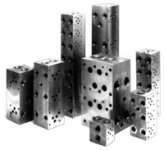in ponding (back yard ponds) and aquiarums. a manifold is normally just a bunch of Tee's and valves. (plastic tees, and possible plastic or metal valves)
but when ya jump into hydrualics for tractors and pressures, it becomes a different world. more so with valves. your generic run of the mill valve you find at local hardware stores for, water, gas, and like. = no good. as in, physically not being able to open or close a valve.
hyd valves, have to pressure compensate, to make the valves real easy to move. and that is were the complication comes in, with all the "holes" that get drilled into manifold blocks, and valve bodies. simply taking a physical look at a valve body or manifold block, and you will get completely lost most likely. you don't really see the difference and what goes were, till ya look at a 3D drawing of a manifold or valve. though most companies downloadable 3D drawings stink. which then ya end up on "youtube" and searching for "animation hydrualic X" were x is a valve of some type or a manifold or some such.
my best suggestion, is get a pad and paper (myself use paint that comes with windows) and draw some stuff up, with simple on/off valves, like a kitchen sink, or garden hose. and start drawing in Tees and valves.
then draw in some connection rods to multi valves. so if you move one valve, another valve also moves (either open or close)
after ya do a few drawings above...
start moving valves closer together, so 2 valves are in same "manifold" or physical body.
then move on up to 3 and 4 and on up to 8 valves. all in a single motion. of one connecting rod, you open some valves and close others. and when ya move the connecting rod to all valves in opposite direciton, some valve close and others open.
once you get past the standard on/off valve for say a garden hose. and start to understand how a bathroom bathtub / shower combo work (water into bathtub valve, 1 cold valve, 1 hot valve, 1 shower head valve, 1 shower head on a hose (washing dogs) on a valve)
you can start moving into "spool valves" spool valves are the magic item in most hydrualic valves on tractors. though there are some poppet style valves used.
================
most of the big companies that sell valves and manifold blocks, just go download there brocheure for valves and manifold blocks, they normally give a huge PDF file, with a good amount of text, but not really a very detailed images of things and end up using a default schematic drawing symbols. again this is about time ya switch over to youtube and search for this or that, as ya follow through the type of valves and explanations.
================
what makes matters worse for folks when dealing with tractor valves, is normally there are pressure relief valves, power beyond ports, and extra features say, float or detent for a generic tractor valve, and ya don't simply start with an easy "on/off valve" but ya have a fairly advance valve to begin with. not to mention instead of a lever or 2 or 3, you may have a joystick, that complicates things even further.
and of course hydraulics has its own lingo... they simply do not state, "low pressure / tank" high pressure hyd cylinder, low pressure hyd cylinder, etc... they use A,B,C,D,T,P and possibly adding a number in there A1,A2,B1,B2, etc... to the letters.
and above is just for valves...
============
hyd pumps, hyd motors. that is a completely different subject all together. ya it gets a little daunting,
don't be afraid to hit some elementary school websites for simple math (doh) been there done that. and not remembering the yack yack bloody theorem of this or that.

